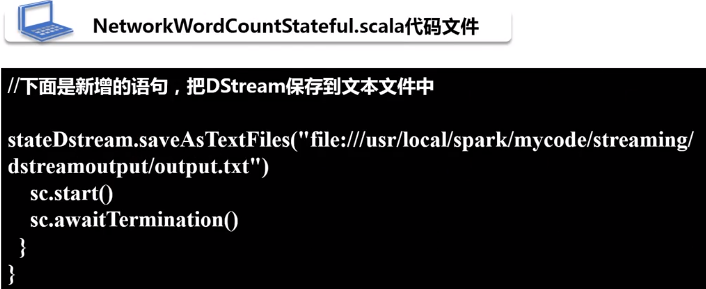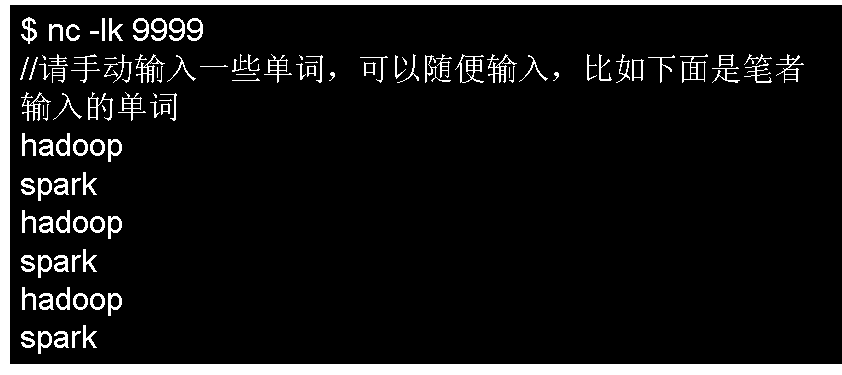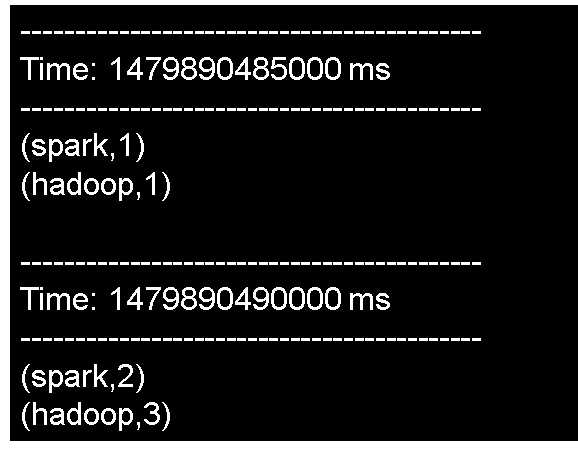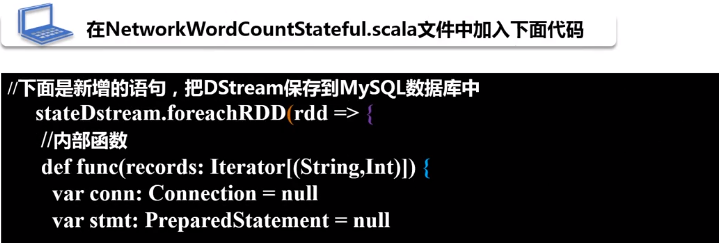在Spark应用中,外部系统经常需要使用到Spark DStream处理后的数据,因此,需要采用输出操作把DStream的数据输出到数据库或者文件系统中。
一、把DStream输出到文本文件中

请在NetworkWordCountStateful.scala代码文件中输入以下内容:
package org.apache.spark.examples.streaming
import org.apache.spark._
import org.apache.spark.streaming._
import org.apache.spark.storage.StorageLevel
object NetworkWordCountStateful {
def main(args: Array[String]) {
//定义状态更新函数
val updateFunc = (values: Seq[Int], state: Option[Int]) => {
val currentCount = values.foldLeft(0)(_ + _)
val previousCount = state.getOrElse(0)
Some(currentCount + previousCount)
}
StreamingExamples.setStreamingLogLevels() //设置log4j日志级别
val conf = new SparkConf().setMaster("local[2]").setAppName("NetworkWordCountStateful")
val sc = new StreamingContext(conf, Seconds(5))
sc.checkpoint("file:///usr/local/spark/mycode/streaming/dstreamoutput/") //设置检查点,检查点具有容错机制
val lines = sc.socketTextStream("localhost", 9999)
val words = lines.flatMap(_.split(" "))
val wordDstream = words.map(x => (x, 1))
val stateDstream = wordDstream.updateStateByKey[Int](updateFunc)
stateDstream.print()
//下面是新增的语句,把DStream保存到文本文件中
stateDstream.saveAsTextFiles("file:///usr/local/spark/mycode/streaming/dstreamoutput/output.txt")
sc.start()
sc.awaitTermination()
}
}
sbt打包编译后,使用如下命令运行程序:

程序运行以后,屏幕上就会显示类似下面的程序运行信息:

打开另外一个终端,作为单词产生的源头,提供给NetworkWordCountStateful程序进行词频统计:

运行NetworkWordCountStateful程序的监听窗口,就可以看到类似下面的词频统计结果:

这些词频结果被成功地输出到“/usr/local/spark/mycode/streaming/dstreamoutput/output.txt”文件中
![]()
可以发现,在这个目录下,生成了很多文本文件,如下:

output.txt的命名看起来像一个文件,但是,实际上,spark会生成名称为output.txt的目录,而不是文件。
二、把DStream写入到MySQL数据库中
启动MySQL数据库,并完成数据库和表的创建:

在此前已经创建好的“spark”数据库中创建一个名称为“wordcount”的表:

在NetworkWordCountStateful.scala文件中加入下面代码:


把partition里面的每条记录用func函数写到底层的MySQL数据库当中去
完整代码:
package org.apache.spark.examples.streaming
import java.sql.{PreparedStatement, Connection, DriverManager}
import java.util.concurrent.atomic.AtomicInteger
import org.apache.spark.SparkConf
import org.apache.spark.streaming.{Seconds, StreamingContext}
import org.apache.spark.streaming.StreamingContext._
import org.apache.spark.storage.StorageLevel
object NetworkWordCountStateful {
def main(args: Array[String]) {
//定义状态更新函数
val updateFunc = (values: Seq[Int], state: Option[Int]) => {
val currentCount = values.foldLeft(0)(_ + _)
val previousCount = state.getOrElse(0)
Some(currentCount + previousCount)
}
StreamingExamples.setStreamingLogLevels() //设置log4j日志级别
val conf = new SparkConf().setMaster("local[2]").setAppName("NetworkWordCountStateful")
val sc = new StreamingContext(conf, Seconds(5))
sc.checkpoint("file:///usr/local/spark/mycode/streaming/dstreamoutput/") //设置检查点,检查点具有容错机制
val lines = sc.socketTextStream("localhost", 9999)
val words = lines.flatMap(_.split(" "))
val wordDstream = words.map(x => (x, 1))
val stateDstream = wordDstream.updateStateByKey[Int](updateFunc)
stateDstream.print()
//下面是新增的语句,把DStream保存到MySQL数据库中
stateDstream.foreachRDD(rdd => {
//内部函数
def func(records: Iterator[(String,Int)]) {
var conn: Connection = null
var stmt: PreparedStatement = null
try {
val url = "jdbc:mysql://localhost:3306/spark"
val user = "root"
val password = "hadoop" //数据库密码是hadoop
conn = DriverManager.getConnection(url, user, password)
records.foreach(p => {
val sql = "insert into wordcount(word,count) values (?,?)"
stmt = conn.prepareStatement(sql);
stmt.setString(1, p._1.trim) # 第一个字段,去掉空格的字符串
stmt.setInt(2,p._2.toInt) # 第二个字段
stmt.executeUpdate()
})
} catch {
case e: Exception => e.printStackTrace()
} finally {
if (stmt != null) {
stmt.close()
}
if (conn != null) {
conn.close()
}
}
}
val repartitionedRDD = rdd.repartition(3)
repartitionedRDD.foreachPartition(func)
})
sc.start()
sc.awaitTermination()
}
}